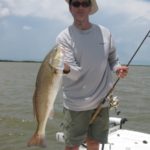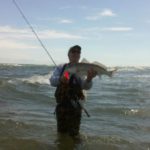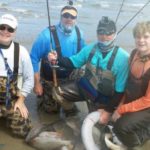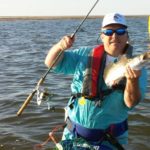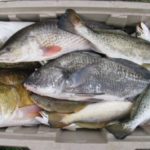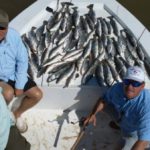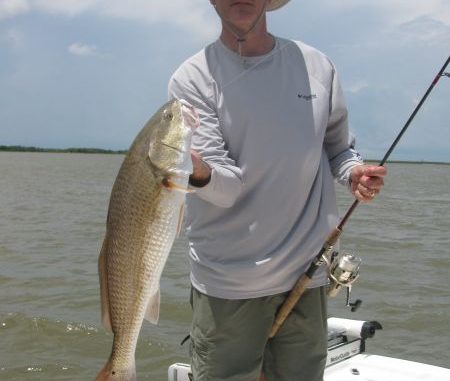
Sure, you can burn the gas to get out to Gosier Island and catch some nice trout this month. But this is what you need to know if you want to burn a fraction of the gas and have non-stop action.
The sun peeked over the eastern horizon from behind murky clouds, while an easterly breeze carried the scent of rotting catfish and stingrays that littered the shoreline.
Some of the stingray carnage was ours. “Flounder” gigs, they call them. But stingrays are much more plentiful than flounders out here nowadays. How nobody got stung in the melee we could not understand.
Gnats and a few mosquitoes bedeviled us, but we could barely work up the energy to swat them. A putrid slime seemed to cover us, a consequence of that sickening humidity of early coastal mornings. It clung to our sunburnt skin along with the sand and grit that filled our sleeping bags. When we got in them last night we were in no condition to feel it; they could have been full of broken glass, black widows and water moccasins, and we wouldn’t have felt them, either.
After a few hours of rolling around in the sleeping bags on the hard, lumpy ground while horribly sunburnt and covered with greasy Skin-So-Soft, the agony began to manifest.
Such a bed does wonders for your back. I doubt any of us had actually slept for more than 15 minutes at a time, the mosquitoes constantly whining by our ears, biting our noses and foreheads.
It was a long night.
“Why do we do this?” came a muffled shriek from Pelayo’s tent.
“Never again!” Eddie bellowed in response.
The minutes dragged by like dead animals until the blessed dawn. Finally we emerged, creaking and groaning from the tents, and shuffled around the malodorous remains of the campfire like stroke victims and winos.
Or like sumo wrestlers. Ever see them squaring off, stomping around with their legs apart? Well, we hadn’t changed our shorts in two days: The sand and saltwater rubbing around in there resulted in a condition we got as babies.
But we were luckier then. A soft, female hand provided relief, applying soothing ointments as we kicked our legs and gurgled in glee.
Nothing like that nowadays. We’re all married, so barring some supernatural event, I suspected we’d all be applying our own ointment.
Pelayo was slumped on his cooler, weary and sullen, with red, swollen eyes sunk deep in bag-lined sockets. He (actually we all) had a wino-like, two-day-old stubble that made an ideal haven for gnats. Our necks were peppered with their stings and streaked in red from our frantic scratching that stopped only when we drew blood.
Eddie was oblivious to the world around him and what anyone might think of his appearance, which was hideous. On a whim he’d brought his guitar for some “campfire singing.” Given the festive tenor of the evening, the mellow Dylan tunes quickly morphed into Eddie’s famous Jimi Hendrix routine.
You might recall that Jimi often strummed his Stratocaster’s strings with his mouth. Naturally this momentarily blocks the guitarist’s vision. Stumbling around in the sand on the edge of a campfire is perilous enough with unblocked vision, right? Footing can be tricky.
At the Monterey rock fest, Jimi famously climaxed his set by setting his guitar on fire — but on purpose, with lighter fluid.
Eddie’s guitar, being a cheap, wooden acoustic, flamed up as gloriously — but without the aid of any flammable liquids.
Now Eddie sat on an ice chest staring balefully at the blackened remnants.
“Gosh, it sure seemed funny last night,” said the look on his face.
His shorts and sunburnt arms were covered in crusted fish slime. His cheeks were smeared with what looked like barbecue sauce, but could have been anything from campfire soot to sheepshead guts.
Saban coached LSU at the time, and Haslett Da Saints.
Ah, yes, “the Breton Island Blast” we used to call it.
We pulled it off once a year around Fourth of July. But we finally wised up and stopped calling Doc “a wuss” for staying in his Venice-based luxury houseboat while we “roughed it — like real men!”
Now we’re all proud wusses, luxuriating the evenings and nights on Doc’s houseboat. Then enjoying Breton and Gosier islands from a safe distance during morning and midday, while casting around them.
The 12 old Tigerland college chums (“Da Dirty Dozen”) now converge at Doc’s Venice houseboat for three days of serious fishing, serious revelry and serious reminiscing — in a much-more comfortable setting. On top of the luxuries, it would be difficult to imagine a more centrally located fishing headquarters than Doc’s houseboat. ESPN, after all, rated Venice “the top fishing port in America.”
We can argue about that till the cows come home, but there’s no denying the options down here. Out of Venice with 20-foot-plus boats, the options are mind-boggling.
Out to Breton and Gosier Island and Breton Sound for specks? To the Canyon or Lump for tuna and wahoo? To Blind and Redfish bays for specks and reds? To the spillways for reds? Out through Red Pass to the shallow West Deltas for pompano, Spanish and mangroves? To the roseau coastline from Grand Pass around to Red Pass for redfish action? How ’bout the rocks at South or Southwest passes? If you can’t catch bull reds there — hang it up!
The options — all delicious to contemplate — can drive a fanatical fisherman dizzy. No fishing locale in America offers such diversity.
Not even close.
Alas, this trip looked doomed. The options had narrowed drastically. A hellaciously high Mississippi River, coupled with blustery southeast winds had whipped every ounce of water in every nook and cranny of marsh around Venice into the color of a Starbuck’s Frappucino.
Whoops! Sorry! I mean “the color of a McDonald’s Frappe.” There. That’s more like it. After all this isn’t Fly Fisherman, Outside or Sierra. It’s Louisiana Sportsman.
So please excuse my gaffe.
But as so often happens lately, Google Maps came to the rescue. Given the river’s crazy ups and downs lately, coupled with the absence of levees from Ostrica down on the east side of the river, this delta marsh landscape changes faster than Lon Chaney Junior’s face on a full moon.
Canals and channels silt up to prop-churning dimensions. Ponds fill. New passes and channels open. But these Google aerial pics are usually updated annually. So one can kinda follow the terrain mutations.
Still and all, often there’s no way to tell the depth of a canal or pass we zipped through the previous year until — WHOOOOA! — the motor gives a ghastly roar, and Pelayo and Artie are tumbling around the bow, groaning and rubbing their heads and elbows.
“Y’all knock yourselves out,” Pelayo waved at Doc, Spencer, Johnny “Da Legend” Morise and the rest of his crew as they shuffled around the houseboat in the predawn haze preparing to head deep into Breton Sound. “High tide ain’t till 10:20 a.m. in Jack Bay (our reference point for fishing this area.) And we ain’t beating ourselves to death making the long haul to Gosier Island. No way. We plan on cork fishing the marsh around Deep-Waaaw-daw point.
“So we’ll be sleeping in, eating a leisurely and hearty breakfast of Bambi sausage (in patties) and biscuits, sheepshead seviche and shrimp omelets. Then we’ll head out to catch the falling tide. That way we’ll hopefully find a few pockets of semi-clean waaaw-daw. But we’ll be checking in with y’all during the day. Have fun!”
What we were Google-mapping for were ponds that are mostly enclosed, as in drained and filled via one or two small trenasse. These conditions shelter the pond water from the fast current and whipping wind. Even better, in this area these ponds often choke up with Eurasian milfoil (that grass most of y’all erroneously call “hydrilla”) widgeon grass and algae. All this serves to keep these pockets of water not exactly “clear” but at least a few shades less dirty than the surrounding river-infused, wind-whipped water.
Poling or troll-motoring into such ponds in the area roughly from Ostrica to Main Pass and sight-casting for scattered reds works for many.
But we prefer to anchor near the mouths of the trennases or canals that drain them. It’s not exactly rocket science to spot the darker water draining from them during the falling tides and mixing along current lines with the dirtier river-influenced water. Offshore rips generally concentrate fish. Ditto inshore rips, at least in our experience in this area.
This combination of cleaner water and draining bait morsels often results in schools of rat reds working such areas, usually mixed with their cousins puppy drum and school specks.
Flounder usually crash the party, too. All of our coastal fish prefer huddling in the calm water next to moving current — then zipping out to grab the morsels carried by.
Flounder, however, set up their ambush in the current itself (under it technically, since their body shape means they don’t have to expend valuable energy fighting the current. Mostly they let it wash over them, along with the buffet it carries.)
After our leisurely morning routine, we ran upriver a bit, hung a right through one of the cuts that has opened between Fort St. Phillip and Baptiste Collette, zeroed in on the pond we’d pinpointed by map — and found exactly what we were looking for.
Here the marsh was in transition from fresh to brackish — about half spartina grass and half roseau-cattail.
Just the way we like it.
Pelayo was dropping the anchor when Eddie sent a shrimp-tipped beetle 2 feet under a popping cork to the grassy tip of a feeble spartina island that was backed up by a wall of roseau.
The place had redfish written all over it. The cork splashed about 2 feet from a white PBC pole and never reappeared.
“Hey what the …?” Eddie was frowning, mumbling something about his twisting line when — “WHOOA!”
He reared back on the light-action rod, and the battle was joined. No tight drags and stiff bass rods for us: We like to play fish, to feel those lunges, to savor the screeching runs of a berserk red in shallow water. And mostly, to listen to the scream of a loose drag on a spinning reel.
Eddie’s face looked almost like Jimi’s 10 years ago.
Eddie’s pole seemed on the verge of splintering, and his face was a mask of sheer delight as that bronze torpedo blazed through the shallows. From its wake, you could tell it was a beauty. Probably 5 to 7 pounds.
I grabbed the net just as Pelayo let out a whoop. He was on one, too, and Artie was busy reeling in a school speck from a current line about 50 feet from the grassy shoreline where a tern had just smacked the water.
I finally cast out about 10 yards from the bank in slightly deeper water. I had a white beetle sweetened up with half a shrimp 3 feet under a popping cork (save the gold spoons and spinnerbaits for clearer water. In this murky slop they want maaaw-ket bait on a jig under a cork).
The dirty water current was taking it toward the “rip,” and on the third pop it plunged. I struck back, and the surface exploded in copper.
“We’re on a school!” I bellowed.
Within seconds, two corks landed just yards from mine. And within a few more seconds, those two plunged.
Now Pelayo battled another red that was aiming for deep water.
“Probably a big un!” Eddie yelled as he unhooked his flounder. “Dey always do that!”
After a dozen mixed fish, we hauled up the anchor and headed east through an old, silted-up pipeline canal into the broken island-studded marsh on the edge of what some maps label Grand Coquille Bay. Here we found another draining pond.
The tide was dropping rapidly now, and we could see the little eddies around each point, which had millfoil sprouting from the muddy bottom.
I peeked astern and made out the bottom of the prop through the hazy water. Perfect redfish water.
Just then, a tern smacked the water around the little eddies formed by the outgoing current about 20 yards astern.
“Saw that,” Pelayo said as his cork sailed toward the action.
I turned to see another tern smack near shore, and then heard Pelayo’s grunt.
A red exploded in a copper froth on the surface as his pole bowed.
In minutes Eddie and Artie were on the bow — each tussling with muscle-bound reds that were soon followed by chunky puppy drum.
We didn’t encounter another boat while fishing. But when heading in, a parade of them were heading back from the open waters of Breton Sound and crossing the river at Baptiste Collete — one of them was Johnny’s, another Doc’s.
Pelayo was all smiles as he pointed at them — then at his gas gauge. We knew what he was thinking: “Our round trip had barely topped 8 miles.”
Back at Doc’s we tallied it up and found that their crew had us beat in sheer numbers. Their box was crammed with nice specks, along with a few chunky reds. We didn’t limit out either, but ended up with a gorgeous “box-a-mixed,” after action that seemed non-stop.
Legendary Breton Sound speck aficionado Johnny Morise didn’t need much prodding to share the secrets of his boat’s archtypical success that day on Gosier Island.
“I’ve been fishing these islands a long time, Hom-Boy-Da! Ya follow me?” he whooped while high-fiving with his crew. “So we just don’t wade around randomly hoping to stumble upon a random school of specks or reds. No way: Me and my crew always zero in on the southeast tip of Gosier, ya unnerstan’ what I’m sayin’? Here’s a place we’ve nicknamed ‘Da Trench.’ It’s true that with prime conditions — clear, calm waaaw-daw, plenty baitfish — specks and reds can be found scattered just about anywhere along either side of this barrier island.
“But it’s a nice little haul out here by boat, ya follow what I’m sayin’? So to economize on time, we try to zero in on the most likely speck and red havens. So we usually head straight to that ledge along the southeast tip of the island. Here the waaaw-daw drops off to 12 feet or so from the normal 3-foot depths of most of the coastline. As most fishermen know — whether they specialize in coastal, fresh or blue waaaw-daw fishing —ledges usually hold fish.
“Well, as usual we found a good current line at Da Trench, along with a few schools of mullet. That’s an important factor, I’ve come to believe. So we got out, started casting — me with my favorite Badonk-A-Donk — I just LOVE to watch ’em SMASH it! — dat gorgeous explosion! — ya follow what I’m sayin’, Hom-Boy-Da?!
“The rest of the crew had an assorted ranging from MirrOlures to various plastics from Matrix Shads to cocahoes. It was hard to say which worked best. But as you can see, we really put the ants on ’em. Somebody was always on a fish. We had a blast!”
